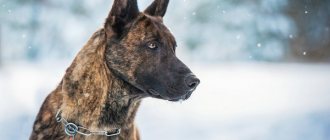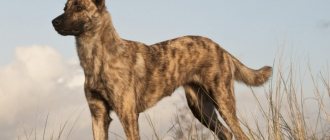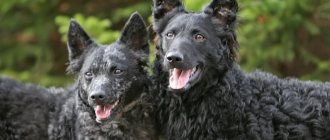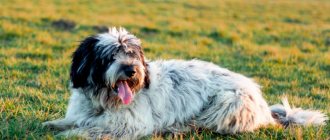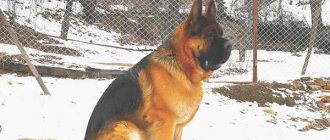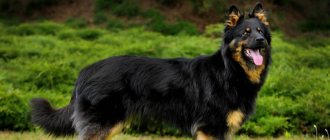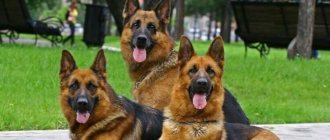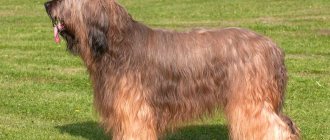The Chapendois is one of the most ancient and famous breeds in Holland. During the period of its formation, the breed was renamed more than once, but the most common name (in Holland) remained the Dutch Poodle or Shepherd. According to their purpose, Chapenduses are classified as shepherds, and in the modern world, four-legged animals are classified as sporting and very loyal companions.
Origin story
Before the Second World War, in every Dutch field where a flock of sheep grazed, one could meet shaggy multi-colored dogs, barking loudly and driving the cattle at the behest of the shepherd.
The prevalence of the Chapendois breed was almost universal. It was impossible to imagine a sheep farm without such a watchman for many centuries. But where these dogs came from in Holland is not known for certain. According to one version, the ancestors of the Chapendois were Spanish cattle dogs, and the breed itself came to the Netherlands in the middle of the 16th century. The country was then under the rule of the Roman Empire, so it is not surprising that Spanish cattle dogs moved to the Dutch fields. According to another version, the Chapendois is a native Dutch breed of dog, bred by local farmers to guard flocks of sheep. The literal translation of the name from Dutch means “shaggy wool” (otherwise, “dirty wool”)
Since ancient times, these dogs were held in high esteem by farmers and workers, but never attracted the attention of the nobility. In the middle of the 20th century, like many other breeds, the Chapendois found itself on the verge of extinction.
But thanks to amateur dog handler Peter Tupul, she was restored. He found literally several purebred Chapendois in the Dutch province of Drenthe and managed to revive the breed. True, today chapendois still remain very rare, but most likely due to the fact that their main working function is no longer so in demand.
Say a word about chapendus
Often in our country the Dutch Shepherd and the Schapendous are confused. And it’s not surprising, because the first litter of “Dutchies” officially registered in Russia appeared in 2013. Chapendus belongs to the group of herding dogs. According to the FCI, this group bears the serial number 1. Section 1 - Herding Dogs.
The second name for the Schapendus is the Dutch Sheep Poodle. This is a little wrong, because the International Canine Federation classified it as a herding dog - a shepherd dog.
How does the Dutch Shepherd Schapendus differ from a regular one? Appearance first. Chapendus is a ball of fur on the paws. It is so woolly that even the eyes are not visible under its thick layer. Typically, owners have to groom their pet twice a year.
Secondly, character. These absolutely non-aggressive creatures get along peacefully with cats and other dogs. Unlike herders, they are stubborn. And you need to start working with them as early as possible. Dogs are very smart and easily remember commands. But they will definitely compete with the owner for the title of leader in the house.
Currently, chapendus, like its closest relative from Holland, is a rare guest in Russia. The price of such a puppy is quite high: from 25 thousand rubles and above.
Pumi diseases
The life expectancy of most representatives of the breed is 12–14 years, and active Pumi are predominantly in good health. There are several problems that are most common among Hungarian shepherds:
- Dysplasia and luxation of the kneecap. This disease is inherited, so when choosing a puppy, new owners often insist on a genetic test. Congenital predisposition in the form of bone deformation and increased mobility of the tibia relative to the thigh often leads to the need for surgical intervention. It is not difficult to suspect that a dog has a problem - it will begin to protect its paw, whine when walking, and refuse to climb stairs. Ignoring dysplasia is a direct path to partial immobilization and suffering of the animal.
- Ophthalmological diseases, in particular, dislocation of the lens of the eye. Failure of the ligaments in the eye leads to displacement of the lens, which often occurs due to injury or developing cataracts. The breed's predisposition to the problem requires special attention from the owner - if the appearance of the pet's eye changes, it becomes cloudy, tearing or pain increases, then you should immediately go to the doctor. If the problem is not treated (which most often requires surgery), the dog will go blind.
The national Hungarian Pumi breed is medium in size and has a cheerful, energetic behavior. It is perfect for owners of houses outside the city, where there is the opportunity to walk and run a lot. The main feature of the breed is its curly coat, which requires careful care.
Training and education
High mental abilities, intelligence and the need for encouragement make the chapendois an easy object to train. But the dog’s character also has traits characteristic of shepherds - the ability to make independent decisions, assess the situation and react accordingly, which makes the dog somewhat stubborn.
The trainer requires tolerance, patience and kindness. The dog does not tolerate violence and rudeness, so training should be supported by signs of encouragement and exclude coercion. An intelligent dog quickly masters any number of commands, carefully carries them out, and enjoys learning not only the mandatory course, but also various tricks.
It is better to start training dogs at 12 months, and educate them as early as possible. A dog will only become the best companion when it is socialized from an early age. High physical activity, endurance, and a huge supply of energy require significant physical activity.
If a dog lives in a city, then simply walking around the house or in the park will not be enough for it. The best place for walking will be a training ground. Here the dog will not only satisfy the need to communicate with the owner, but will also learn to communicate with his relatives and throw out excess energy.
In Holland, chapendois often take prizes in various competitions - agility, running, flyball, frisbee. In terms of speed, chapendois are almost as good as greyhounds; they are maneuverable, jump high and are extremely resilient. These qualities are used in training courses. When classes are conducted taking into account the physical and mental qualities of dogs, they learn new skills very quickly.
What to feed
It is necessary to know in advance what to feed Chapendous puppies, because the stomach of these dogs is a weak point. First of all, it is not recommended to give them small and tubular bones. Dry food must be present in the diet, because it, as a rule, contains a lot of vitamins and microelements that a growing dog needs.
You can find out from sellers what to feed Chapendus, although in Russia it is difficult to find a real nursery for breeding this breed. Despite their easy-going nature, Chapenduses are quite picky eaters. But this is only the first time. They can be trained to eat homemade food, but it will take some time.
Until two months old, Chapendus puppies eat exclusively their mother's milk. In the third month of life, it is recommended to slowly introduce porridge into the diet. Gradually add meat to it, mainly beef. Chapenduses love pork, but it negatively affects their intestinal function.
Nutrition
Schapendus is absolutely not picky about food. Premium food for medium dogs is suitable for him. Such feeds are balanced and do not require the use of additional vitamins and fertilizers.
If you still decide to feed your dog natural food, then the schapendus’ diet should contain about 200 grams of meat daily, with a total diet of 500 grams. Meat can sometimes be replaced with poultry or offal. But keep in mind that the nutritional value of offal is much lower than meat, so the amount of it in the dog’s diet should be slightly increased. In addition to meat, it is necessary to include cereals (preferably buckwheat or rice), vegetables (with the exception of legumes and potatoes), as well as vitamins and mineral supplements.
We should not forget that the dog should always have fresh water freely available.
Character and characteristics of the breed
If we talk about the character of the chapendus, then its cute and charming appearance fully corresponds to the cheerful and friendly temperament inherent in the representatives of the breed. Due to its wonderful character, the Chapendus is not only a popular herding dog, but it is also kept exclusively as a companion and family dog. In particular, in this role he gained great popularity in France. Chapendus is an excellent pet that will not only easily find a common language with absolutely all family members, but will also be able to perform security functions. Representatives of this breed adore children, which makes them excellent and reliable nannies. They also get along well with other pets, over whom they often take patronage and look after them.
general characteristics
Initially, the breed was used exclusively as a sheep herder. It was a native herding breed, which is why it was on the verge of extinction when the number of sheep in the Netherlands decreased. But today her role has expanded. It can, as before, be used to protect sheep; some breeders purchase it to protect a house, yard or apartment. This intelligent animal is always welcome at exhibitions and competitions. But, in addition, such a pet will be the best friend of the family or an ideal companion.
According to breed standards, the height of a male should range from 43-50 cm at the withers, and that of a female - 40-47 cm. Weight should not exceed 15-20 kg.
Description of the breed
Schapendus is primarily a herding and herding dog. She is very fast, resilient and jumping, as befits a real shepherd dog. This breed has a kind, friendly disposition.
Externally, it is a long-haired dog with a fairly light build.
Her unusual appearance attracts the attention of others
Schapendus loves to work. If you decide to get this breed of dog, you will need to come up with an interesting activity for your pet so that he doesn’t get bored and start misbehaving at home. Schapendus will be happy to engage in agility or Frisbee, as well as participate in all kinds of competitions for dogs.
Schapendus is very devoted to his owner; you will not find a more attentive and thinking dog than him. Schapendus is ready to do anything for his beloved owner and will prove this to you every day. This dog will be an excellent play and walking companion for you and your children, especially since the dog is completely devoid of aggression.
Due to its small size, schapendus can be kept in a city apartment, providing long walks. If you have enough time for active walks, like to go out of town, into nature, and are not afraid of daily grooming, then choose this dog. And she, in turn, will become a devoted, cheerful friend for you, and will delight you with her sporting achievements.
Maintenance and care
Thanks to their high level of intelligence and excellent obedience, raising and training chapendus is a very exciting and easy process that will bring pleasure to both the owner and his four-legged pet.
As for the living conditions, thanks to its small size, the chapendus can easily get along in a city apartment. However, do not forget that by nature this dog is very active and mobile, and therefore it needs regular long walks with the opportunity to frolic and run around without a leash.
Health and life expectancy
Chapendois are generally hardy and healthy. The average life expectancy is 13-14 years. A small number of dogs suffer from progressive retinal atrophy. Clubs in Canada and the United States also recommend that breeders screen for hip dysplasia.
In 2006, German veterinarians discovered that liver enzymes were highly elevated in many healthy Chapendois. Further observation showed that this was not associated with any diseases. Dogs with pathologically elevated levels lived to old age and did not complain of liver-related health problems.
To maintain the health of the chapendus, owners are advised not to forget about veterinary preventive measures: vaccination, treatment for parasites, regular medical examinations.
Health
The Chapndu's genotype is very good, so severe diseases are rare in this breed. If not properly cared for, inflammation of the cornea, retinal atrophy, and ear infections can develop. Skin diseases, formation of tangles.
On the PetStory service you can learn more about this breed, as well as find a good veterinarian. By the way, by installing a special application, you can consult with a veterinarian online with video broadcast. You will also have access to a database of veterinary clinics, an appointment with a specialist, and a map with places where you can relax with your pet.
Download the specialized application for pet owners Petstory on the IOS and Android platforms using the link – https://petstory.ru/prilozhenie-konsultacija-veterinar/.
Section 2. Cattle dogs
Australian Heeler (Kettle Dog)
RN FCI - 287 Height at withers: males 46-51 cm, females 43-48 cm. Color: blue (also blue piebald or speckled) with or without black, blue or reddish markings, red speckled with or without dark red markings them. Homeland: Australia. A strong, resilient, hardworking dog. Strong, vigilant, conscientious and loyal. It happens with a congenital short tail. Short-tailed animals are not recognized by the FCI.
Bouvier des Ardennes
RN ICF - 171 Height at the withers: medium - less than 60 cm, large - above 60 cm; females - a little less. Color: any. Homeland: Belgium (Ardennes). A working cattle dog, weather-resistant, powerful, and has a sense of its own territory.
Can Fila di San Miguel
RN FCI - 340 Height at the withers: males 50-60 cm, females 48-58 cm. Color: grayish, gray, yellow, always with brindle, with or without white markings. Homeland: Portugal (Azores) An excellent watchman, a reliable protector, a self-confident dog, with a lightning-fast explosive temperament.
Header coat
There are three types of wool:
- Shorthair – uniform hair throughout the body. The fur is slightly longer on the hips and tail. The undercoat is thick.
- Longhair - the hair is long, straight, with a thick undercoat. The muzzle, ears, hind limbs up to the hocks and paws are covered with short hair. The back of the forelimbs has feathering. The tail has long hair. Ears without fringes;
- The wirehair is the rarest type of dog, even in its homeland. The coat throughout the body, except the muzzle, is short and hard, tousled with undercoat. There is a kind of beard on the muzzle. Eyebrows stand out noticeably. There is less hair on the frontal part of the head, on the ears and cheekbones. On the hind legs the hair forms “pants-like fringes”.
The Herder with short and long hair has a color typical only for this breed. They have yellow fur interspersed with black stripes. When shedding, yellow hairs are more noticeable, then darker ones. The muzzle has a black mask. Breeders strive to achieve a spotted pattern with a golden hue. The final color becomes visible by one and a half or two years of the animal’s life.
The wire-haired variety has the following colors: gray with a blue tint, pepper and salt, motley or brindle on a fawn and sometimes yellowish-brown background.
Disadvantages of colors of all types:
- presence of white spots;
- no mask;
- plain color;
- other colors not provided for by the standard.
Character of Chapendois dogs
The Dutch Shepherd has all the guard skills and knows how to be a shepherd. The pet is playful, hardy, and always ready to help. The dog does not show aggression. If there are small children in the house, then the chapendois will be their nanny and assistant.
It is easy to teach a dog simple commands. The Dutch Shepherd hardly barks, but will not let strangers into the house. If friends come to you, then the chapendois will treat them kindly.
The character of the animal is flexible and balanced. The pet always understands when you have time to play and when it is better not to approach the owner. He becomes attached to all family members and values each person. Chapendus loves affection, so you should pet your pet as often as possible.
Advantages of the breed:
- unpretentiousness in content;
- intelligence and intelligence;
- good health.
Newly born puppies feed on their mother's milk and cannot be separated from their mother for several months. Dogs gradually get used to an adult diet, so the amount of food needs to be increased by a few grams each time. It’s easy to control your pet’s weight: based on weight and height, you need to increase or decrease the amount of food, and correctly calculate its norm, taking into account age and parameters. As a last resort, you can seek help from a veterinarian.
This breed is highly intelligent, so there will be no problems with training. Training should begin from birth, so that from an early age the puppy understands what can be done and what cannot be done.
Schapendus is an unusually cheerful, playful and friendly dog. She is absolutely not prone to aggression or inappropriate behavior. But, despite the fact that she gets along well with others, allows herself to be stroked and bothered by everyone, still the main authority for her remains only her owner. These shepherds are always infinitely loyal and grateful to the people who raised and raised them.
In their profession as shepherds, Chapendoises are unique in their own way. They are friendly towards the sheep they graze and do not try to bite or injure them. But at the same time they persistently and clearly manage the herd. It is difficult for a timid sheep to stay in place and not obey the dog, which, in the form of a large ball of wool, rushes at full speed towards the troublemaker, accompanying its movement with a ringing bark.
Despite the fact that the dog’s eyes are covered with a “curtain” of wool, he sees vigilantly and carefully follows the actions of the shepherd and his gestures-commands. If the herd is occupied by two or three chapendois shepherd dogs (and this most often happens), then you can be calm - the entire population of animals is under reliable protection and is moving in the right direction.
Chapendois are surprisingly energetic and active dogs that require constant movement and proper attention to their shaggy person. They are also quite noisy and loud-voiced, as befits real shepherd shepherds. Unfortunately, their noisy behavior when living in apartments sometimes creates conflicts with neighbors.
In the urban conditions of small Dutch towns, chapendois also feel great and quickly learn to behave in a disciplined manner.
And this is not unimportant - in the Netherlands the owner is allowed to bring the dog everywhere, be it a store or a restaurant. It is only important that the animal is on a leash and behaves with dignity
The Chapenois is an excellent family dog, especially well suited for large families. These nimble shepherds do not like loneliness and need constant communication with someone.
Left alone in the house, they are able to quickly “put things in order”, but not at all in order to do harm, but to attract attention to themselves
READ How many months do German Shepherd ears stand up?
The Chapendois dog is unique for its intelligence and excellent learning ability. It is not difficult for him to master the necessary commands or a few funny tricks. But the most important thing for this dog is the ability to move quite a lot. She especially enjoys long walks through the forest or meadow.
Character
Chapendois are distinguished by an extremely complacent and flexible disposition. We can say that aggressiveness is not characteristic of the breed at all. Dogs are very inquisitive and loyal. Moreover, despite the fact that the dog chooses one owner for himself, due to the lack of a tendency to dominate, he also treats all family members equally. Moreover, he considers his family to be his flock, which he is obliged to protect. For young children, the chapendois can be an excellent nanny, and for teenagers - an excellent companion for active games.
The guarding and watchdog qualities of the breed are always evident, and not only when working as a shepherd. The dog will defend the entrusted territory very clearly: without showing aggression, he will not allow strangers into the house. Chapendois literally need human communication. And not only in games and tactile caresses, but also in conversation. An amazing feature of these dogs is to listen carefully to their interlocutor, and without such monologues from the owner, the chapendois may even become depressed.
Hurry up, choose a box and find out what gift awaits you
Discount on pet insurance
Promo code copied to clipboard
Schapendus
After World War II, schapenduses were on the verge of extinction, but now they are becoming popular again in European countries. In 1947, the first club of lovers of this breed was created, and in 1971 the standard was approved.
Representatives of this breed are especially common in their homeland - the Netherlands. These are hardy and fearless dogs; which are not aggressive at all, but are always ready to protect the owner. Cheerful and playful pets can sometimes be stubborn, but with firm upbringing they are very obedient. The main thing is not to let them dominate and allow them to throw out the accumulated energy during walks.
Schapendus were originally bred as herding dogs, but nowadays they are kept primarily as companions. The growing popularity of the breed is largely due to the friendly and good-natured disposition of its representatives. Schapendus will never refuse to play with his family and simply loves to communicate with them.
Upbringing
This breed requires obedience training. They need to be trained strictly, but not harshly. Schapenduses have a hard time dealing with rudeness and disrespect. When handled properly, the dog easily and happily obeys commands. These dogs are very jumping and love active training.
Pets raised at home grow up to be less self-sufficient and independent than those who are used as shepherds. But in any case, Schapendus by nature remains a vigilant guard.
During walks, dogs need active physical activity. Pets feel more comfortable if they can run around freely, so life in a private house with a fenced area is better suited for them.
Behavior
Schapendus vigilantly guard the surrounding area and do not allow strangers to enter their territory without the permission of their owners. At the same time, pets behave quite friendly with family friends. At home, they rarely bark and are very calm. Even if there are already animals in the house, shapendus try not to conflict with them. They love comfort and a calm atmosphere in the family, without frequent quarrels.
Features of care
Dogs of this breed are very easy to care for, so even an inexperienced owner can handle them. The wool does not require complex cutting, and the owner does not need special tools or special products. You just need to brush your dog about once a week with a wide-toothed brush and wash it as needed.
Schapendus have good health, so you usually only need to visit the veterinarian for routine preventive examinations.
Schapendus puppies
From the first days of life, puppies quickly adapt to their environment and begin to actively explore their surroundings. They need to be taught to communicate with strangers from an early age. Dogs are quite easy to train, especially if it is done as a game so that they find it interesting. Puppies respond better to rewards than punishments. If treated harshly, they can become stubborn and withdraw into themselves.
The main thing for the owners of a small schapendus is to spend as much time as possible with the pet so that it feels cared for and does not get bored. In this case, even such active dogs can be kept in urban conditions.
Prices
The breed is considered very rare even in its homeland, Holland. There are probably about 30 nurseries all over the world that deal with chapendois, and there is not a single one in our country. There is also no information about private breeders. Therefore, if you decide to get this particular breed, you need to be prepared that, in addition to the cost of the puppy itself, you will also have to spend money on its transportation. In Holland, you can buy a purebred chapendois for approximately 300 euros; in other European countries or in the USA, the price of a puppy will increase to 500–1000 euros.
Photos: Yandex.Pictures
External standard of the Dutch Shaggy Shepherd Chapendois
A representative of this breed is a harmoniously built, medium-sized shepherd dog, with a unique, memorable shaggy exterior, a friendly and combative character. The size of the dog is quite modest (for a shepherd). The maximum parameters of an adult animal reach the following values: the height of a male is up to 50 centimeters at the withers, the height of a female is up to 47 centimeters. Body weight can be 12–20 kg in females and 12–25 kg in males.
- The head is not too large, but the abundance of hair makes it visually large. The skull is flat, with pronounced brow ridges. The frontal part looks pronounced due to the hanging bangs. The occipital protuberance is developed. The stop (the transition from the forehead to the muzzle) is weakly expressed. The muzzle is shorter than the length of the skull, pointed and slightly blunted at the end of the shape. The bridge of the nose is straight, moderately wide. The nose is large, black or brown (depending on coat color). The jaws are strong. The teeth are white, fairly large, with strong fangs. Scissor bite.
- The eyes are round in shape, quite large, located in the anterior plane of the skull. Because of the shaggy bangs, the eyes are difficult to see. Eye color is dark brown or black. The eyes are very expressive, attentive and intelligent, sometimes mischievous.
- The ears of chapendus dogs are small and set high, hanging freely, covered with long hair (which significantly increases the visual size of the ears).
- The neck is strong and muscular, dry, without dewlap.
- The body of the Dutch Shepherd Chapendois is of a stretched type (the length from the withers to the base of the tail is greater than the height at the withers), with light bones and a physique that is not prone to obesity. The chest is deep and developed. The back is straight. The back line is straight. The croup is small, slightly sloping. The stomach is not too tucked.
- The tail is medium set, rather long, saber-shaped, covered with thick long fur.
- The limbs are straight, moderately long, with light bones and well-developed muscles. The paws are oval and large, completely covered with hair. The paw pads are dense and elastic. Claws are asphalt gray or black.
- The coat is very thick, with a dense dense undercoat, long, wavy and somewhat rough to the touch (should not be soft and silky). The long fur on the back can reach such a length that it can easily reach the ground. There are pronounced featherings on the rear parts of the limbs, reaching a length of 7–8 centimeters. The head and muzzle of the dog are also covered with long hair, hanging over the eyebrows, covering the eyes with bangs and forming a pronounced lush “mustache” and “beard”.
- Color. Any color of animal's fur is allowed. When judging during the championship, bicolor dogs with bluish-gray and black coats have an advantage.
READ White Swiss Shepherd American-Canadian Shepherd
The Chapendois Sheepdog is an exceptionally healthy breed of dog, selected by Mother Nature herself. These cheerful animals get sick extremely rarely, and they do not have any stable breed diseases. With good care and maintenance, Chapendois does not have any health problems.
The shaggy "Dutch" perfectly tolerates both low and high temperatures due to its versatile long fur with a dense, warm undercoat. Also, thick and long hair protects the animal well from scratches and serious injuries from thorny bushes and plants. Representatives of the breed have strong immunity, which allows them to easily cope with infections (which does not exclude routine vaccinations of the animal).
The lifespan of these docile and always disheveled dogs is between 12–15 years.
How to choose a Dutch Shepherd puppy?
When choosing a future pet, focus on the basic indicators:
- availability of documents, veterinary record;
- general health;
- the puppy's parents have titles;
- vaccination;
- integrity of the skin and mucous membranes;
- playful nature, friendliness and activity.
It is important to remember that Dutch Shepherd puppies are prone to overeating. Ask the seller at the nursery how many times a day the pet has eaten and what amount is considered normal for him
Do not change your diet immediately after arriving home. Only after a week can you introduce three meals a day.
We invite you to familiarize yourself with: Composition of the Comfortis flea tablets Use of Comfortis flea tablets in cats
Five to ten puppies are born in a litter. Since the breed is considered genetically healthy and strong, all puppies are very active. Naturally uncommunicative, they are wary of strangers
When choosing a puppy, you should pay attention to the absence of signs of helminthiasis. A swollen belly in a baby of this breed is more likely to indicate worms than rickets
Breeders recommend taking the baby to a new home as early as possible - immediately after the first vaccination—Vaccinations for dogs by age: table—at the age of 7-8 weeks of age. Dogs take a long time to get used to new people, and it is necessary to gain the puppy’s trust so that he recognizes the owner as his master.
You should also get full advice on raising a young Herder:
- What methods should you use to teach him to go to the litter tray in a diaper for the first time—How to teach a puppy to go to a diaper—until the quarantine period ends.
- When to revaccinate.
- What, how and how many times a day to feed a Herder puppy.
The main aspect in the process of raising a puppy is considered to be the choice of behavior tactics with the dog, since they have a difficult character even in puppyhood.
In the CIS countries, the population of Dutch Shepherds is very small. Most representatives of the breed are short-haired and only one kennel deals with wire-haired dogs.
Those who are thinking about buying a Dutch Shepherd puppy should choose the baby not by the photo, but by the parents. It is imperative to evaluate the dogs’ temperament, their working qualities, character, health, living conditions, and the breeder’s attitude towards them.
It is very important in what environment babies will grow up in the first months of their lives, when the foundations of their character are laid.
The type of coat in small puppies can only be determined by an experienced breeder; from a photo it is almost impossible to distinguish between short-haired and long-haired puppies; wire-haired puppies are somewhat different, but only for those who are closely familiar with the breed.
The Dutch Shepherd is small in number and not one of the “fashionable” breeds. Probably, quite an adequate price is associated with this. Puppies from the nursery cost an average of 30,000 rubles. Some promising babies and puppies obtained from field matings or from exported parents with excellent external and performance characteristics can cost significantly more.
The Dutch Shepherd is not represented in Russian kennels, so you won’t even be able to pick up a puppy. In their homeland, the recommended price will be 700–800 euros. It is best to purchase a Herder from foreign nurseries with all the necessary vaccinations and documents.
Education and training
The Dutch Shepherd is very easy to train in any direction. Usually the dog is worked according to standard schemes developed for service breeds. Even faster results can be achieved if the owner establishes a close, trusting relationship with the puppy and finds suitable motivation.
The Dutch Shepherd loves attention, exercise and active games; she is happy to learn new commands and performs them not only for praise or a treat, but also to please the owner. Despite this, it is better to lay the foundation at OKD or in individual lessons with an experienced instructor
When choosing a dog handler, you should give preference to a person who is confident that even with a service dog puppy, training should take place in the form of a game, and not in the form of drills with physical punishment. First of all, the dog must trust the owner and want to complete this or that task.
In terms of use, the Dutch Shepherd is universal. She is capable of working in tracking, search and rescue and herding duties. Shows good results in competitions in agility, obedience, and mondjoring. It can be used as a guide for the blind, since it understands its owner very sensitively and is capable of thinking independently when necessary.
General characteristics. Types and standards
Acquiring an animal is always a painstaking process of studying its characteristics. The Dutch Shepherd is quite problematic to keep in apartment conditions due to the large size of the dog. An inexperienced person may mistake it for a wolf or an unlucky mix of unattractive breeds. The following types are distinguished depending on the coat:
- Shorthair (most common).
- Long-haired (rare, endangered species).
- Wirehaired.
The color can differ radically even among representatives of the same species: from brown with a golden tint to brindle with “gilded” or silver stripes. Monotonous colors, as a rule, are found only in long-haired representatives: black with shades of gray or golden tint. All types of the breed have an impressive physique and the following parameters:
- The height of a male at the withers is 58-63 cm, that of a female is 56-61 cm.
- The average weight of males is 29 kg, females - 24 kg. In some cases, the parameter reaches 31 kg.
- A strong body with well-developed muscles, straight posture, powerful back and lower back, a small head merges with a long muzzle without a noticeable transition.
- Muscular and strong limbs, strong skeleton. Black pads and claws.
- The ears are triangular in shape with a vertical direction and a slight slope back. Short-haired breeds are distinguished by the black color of the fur on the inner surface of the ear, when the color of the other species is the same.
- The eyes are predominantly black or dark shades, almond-shaped.
- The jaws are powerful, with a correct bite, and when closed they repeat the effect of scissors.
- The long tail is curled to the side.
Historical reference
They are closely related to the Bearded Collie, Polish Lowland Sheepdog, Puli, Briard, Old English Sheepdog (Bobtail), Bergamasco Sheepdog and some others. During the Second World War, this breed almost disappeared, and was restored only thanks to the amateur dog breeder P. Toepoel, who collected several surviving dogs. In 1947, the Dutch Chapendus Club was created. Eight years later, in 1954, a breed standard was drawn up, which was only approved in 1968 by the Dutch Kennel Club. Almost 22 years later, in 1989, the breed was recognized by the FCI.
Varieties of the Dutch Shepherd breed
This dog has a slightly ferocious appearance, which is why it is compared in appearance to wolves. And many people think that this breed occurred as a result of a mixture of several breeds. The Herder has three varieties: long-haired, short-haired, and wire-haired. From the names it is already clear that these species are determined by the structure of the dog’s coat. In nature, short-haired Shepherds are much more common, but long-haired Herders, like the Chapendus, are very rare.
The Dutch Shepherd can have different colors depending on what species it belongs to. Dogs with short, coarse hair do not have a uniform coat color. Most often it is brown or golden, and sometimes brindle, that is, with stripes. But the long-haired Herder is most often either pure black or gray, like another type of Dutch cattle dog called the Schapendus. A distinctive feature of all three types of this dog breed is the dark mask around the eyes. Some photographers, when processing photos of herders, darken this detail, making it more noticeable.
Main characteristics
The Dutch Schapendus is very friendly, intelligent, and harmoniously built:
- Head: visually large and wide due to the shaggy long hair, which also sharply emphasizes the dog’s forehead. The muzzle is pointed and slightly blunt and rounded at the end. Strong neck.
- Eyes: round (but not protruding), large and shallow-set, located closer to the front plane of the skull than to the sides. The brow ridges are moderately expressed.
- Teeth: scissor bite.
- Ears: small in size, set high, hanging freely, not fitting tightly to the head. In Chapendus they are very mobile and covered with long hair.
- Body: slightly longer than the height at the withers, the loin is muscular, the bones are light, the ribs are convex and moved forward, the belly is not very tucked.
- Paws: oval, wide, large and springy. Dewclaws are acceptable. They are usually covered with thick fur.
- Tail: saber-shaped, long, covered with thick hair. Carried slightly below the line of the back, with dewlap.
- Coat: thick, long, with well-developed undercoat; feathering on the limbs reaches a length of 7 cm or more. The coat should not be silky - ideally it is slightly wavy and thick, but rough; covers the head and muzzle, forming the eyebrows, beard and mustache. Blue-gray and black colors are preferred, but other shades are acceptable.
Description
The Chapendois differs from its fellow "working dogs" - driven dogs - by its lighter build. The dog’s bones are not heavy, which allows it to easily maintain the gait characteristic of shepherd dogs, but to be more agile and jumping.
A small head with freely hanging ears is crowned with a large black nose. Because of the luxurious bangs, it is not possible to see the eyes right away. But they are quite large in size and have a very good-natured look.
The tail of the Chapendois is quite long, usually hanging low. The dog's fur is one of its distinguishing features. The thick “hair” of the Chapendois makes this dog look like a shaggy bear cub. The hair is quite coarse and slightly wavy. The undercoat is very thick. In some places, the length of the fur can reach 7 cm.
Psychological picture
The popularity of the breed was largely influenced by the good character and certainly cheerful mood of the Dutch Schapendus. Those dogs that are raised in the house as human companions are less independent and self-reliant than those that continue to herd sheep, like their ancestors. But Chapendus is an excellent watchman, and will not allow entry without the owner’s permission, but the pet will be very friendly towards friends and acquaintances. This Dutch Shepherd is very active, obedient, and easily and happily obeys commands. Another advantage of the breed is its balance - the dogs do not show nervousness and rarely bark. Chapendus does not try to conflict or suppress other animals in the house, be it dogs or other animals, so you are guaranteed order and home comfort with them.
Similar breeds by height and weight
Russian Hunting Spaniel Russian Hunting Spaniel - Rossi... Wirehaired Fox Terrier Wirehaired Fox Terrier (international... Sussex Spaniel The Sussex Spaniel is a breed of friends... Manchester Terrier The Manchester Terrier is a rat dog... English Cocker Spaniel English Cocker Spaniel (international... Portuguese Podengue medium The Portuguese Podengue is medium - according to... Portuguese Water Dog Portuguese Water Dog (or Kao-d... Smooth Fox Terrier Smooth Fox Terrier (international... English Bulldog English Bulldog (international name...
When compiling this article, materials from the following sites were used:
Care and physical development
The Dutch Shepherd Dog is unpretentious and is not afraid of bad weather, tempering itself for generations in nature at any time of the year. Caring for this dog is not burdensome even for small owners, because it does not require any special equipment or skills. So, what you still need to remember:
- The dog should look natural, so it is recommended to wash Chapendus only if the pet gets very dirty during a walk. The Dutch Shepherd's coat is prone to felting, so the dog should be brushed once a week with a wide-toothed brush, and only the top part of the coat (the undercoat does not require this at all).
- Chapendus's daily diet should contain 170-200 g of meat (with a total food volume of 400-500 g). This is equivalent to one 800-gram can of canned dog food or 250-300 grams of dry food. Chapendus's health is excellent, and the veterinarian should be visited no more often than for routine preventive examinations.
Care
The long and thick coat of pets of this breed requires daily care. Moreover, it is categorically not recommended to cut the chapendois, since the dog’s thermoregulation may be impaired, which will lead to health problems. Only the bangs need scissors so that the dog still has some kind of view.
In addition, it is also advisable to wipe the chapendois’s face with a damp cloth or napkins after eating. The coat should be combed twice a week with a long comb, using a tangle cutter if necessary. But you don’t often need to bathe your dog, only if it’s very dirty. True, the chapendois has an innate need to wallow in snow or mud in order to fight off its scent (this is how shepherd dogs do not scare sheep), so when keeping it in the city, it is worth thinking about some kind of protective equipment and training. Since it is not recommended to bathe even a city dog more than once every two to three months.
Puppies and training
There are from four to eight puppies in a litter, usually strong and quickly adapting to their environment. They require accustoming to a person from an early age. They are smart, quickly begin to understand commands, and are not stubborn if training is carried out as a game. Chapendus is extremely receptive to training, and in order to get what you want from the dog, you do not need to use harsh coercion. The main thing is to spend as much time as possible with your pet, not letting him get bored without communication. It is under such conditions, as well as frequent walks and trips out of town, that these shepherd dogs can be kept in an apartment - the animals vitally need to move a lot. Therefore, if you are a person who loves active recreation, this breed is for you.
Maintenance, care, health
Schapendus is absolutely unpretentious in maintenance; it is not afraid of bad weather, tempering itself for generations in the open air at any time of the year.
Caring for a dog is very simple and does not require special equipment or skills. Schapendus should look natural, so it is recommended that these dogs take baths only when necessary. The dog's coat is prone to matting, so it must be combed using a wide-toothed comb, and it is not recommended to touch the undercoat at all.
A necessary condition for keeping a Schapendus is to provide him with as much communication as possible so that he does not get bored alone. If you keep a dog in a city apartment, then you need to properly walk this shaggy fidget in order to let the energy seething in him splash out.
